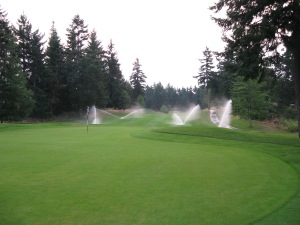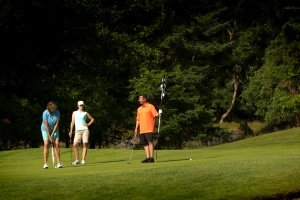The golf industry has longed been accused and criticized for its perceived overuse of synthetic fertilizers and pesticides. Golf Course Superintendents and Assistants are well-trained and experienced turf growers, or agronomists, who take great pride in providing exceptional golfing conditions.
Fairwinds Golf Club is no different. In order to produce excellent playing conditions for 12 months of the year, Fairwinds Superintendent, Rod Siddons, needs to apply enough fertilizers to feed the turf and at times needs to apply pesticides to keep the turf alive. 
We are vitally aware of the potential dangers and negative connotations associated with pesticide use on golf courses and have made great strides over recent years to learn more about what causes turf pest (insects, disease, and weeds) problems and do our best to minimize the problems in order to reduce pesticide use. At Fairwinds, an Integrated Pest Management (IPM) program has been designed to help us limit the amount of pesticides used.
When determining the fertilizer program at Fairwinds, there are many factors to consider including: budget constraints, available labour, application equipment, time of year, and environmental considerations. Soil samples are taken annually from randomly chosen greens, tees, and fairways to get a determination of what nutrients need to be applied to the turf to ensure excellent playing conditions. The samples are sent away to a diagnostic lab where they are studied and the results are used help to determine the fertilizer program.
Organic fertilizers are used as much as possible as they present a much lower environmental impact than synthetic fertilizers; however, they are often less effective and require greater quantities to achieve similar results.
The colour or appearance of the turf, the clipping yield, general turf health, and weather forecasts all help determine the timing of fertilizer applications. It is beneficial to apply fertilizers when it is raining or rain is expected as it helps the fertilizer dissolve into the soil or make it more readily available to the turf plant. Fertilizer applications need to be made when the turf plant can make the best use of the nutrients to ensure efficient use.
Pesticide use on the golf course is limited to the greens and these products are applied on a remedial basis only. Fungicides are not applied until the greens are exhibiting damage due to the presence of a turf disease. The prime disease we fight at Fairwinds is Pink Snow Mold, which can occur with or without the presence of snow and is a pest problem throughout Canada and the northern United States.
Efficient and safe use of fertilizers and pesticides is a priority as we strive to provide excellent playing conditions for members and guests while protecting the environment. If you have any questions or concerns about the maintenance practices at Fairwinds Golf Club, please do not hesitate to contact Rick Munro, our Assistant Superintendent, at rmunro@fairwinds.ca.
Rick Munro
Assistant Superintendent
Fairwinds Golf Club

